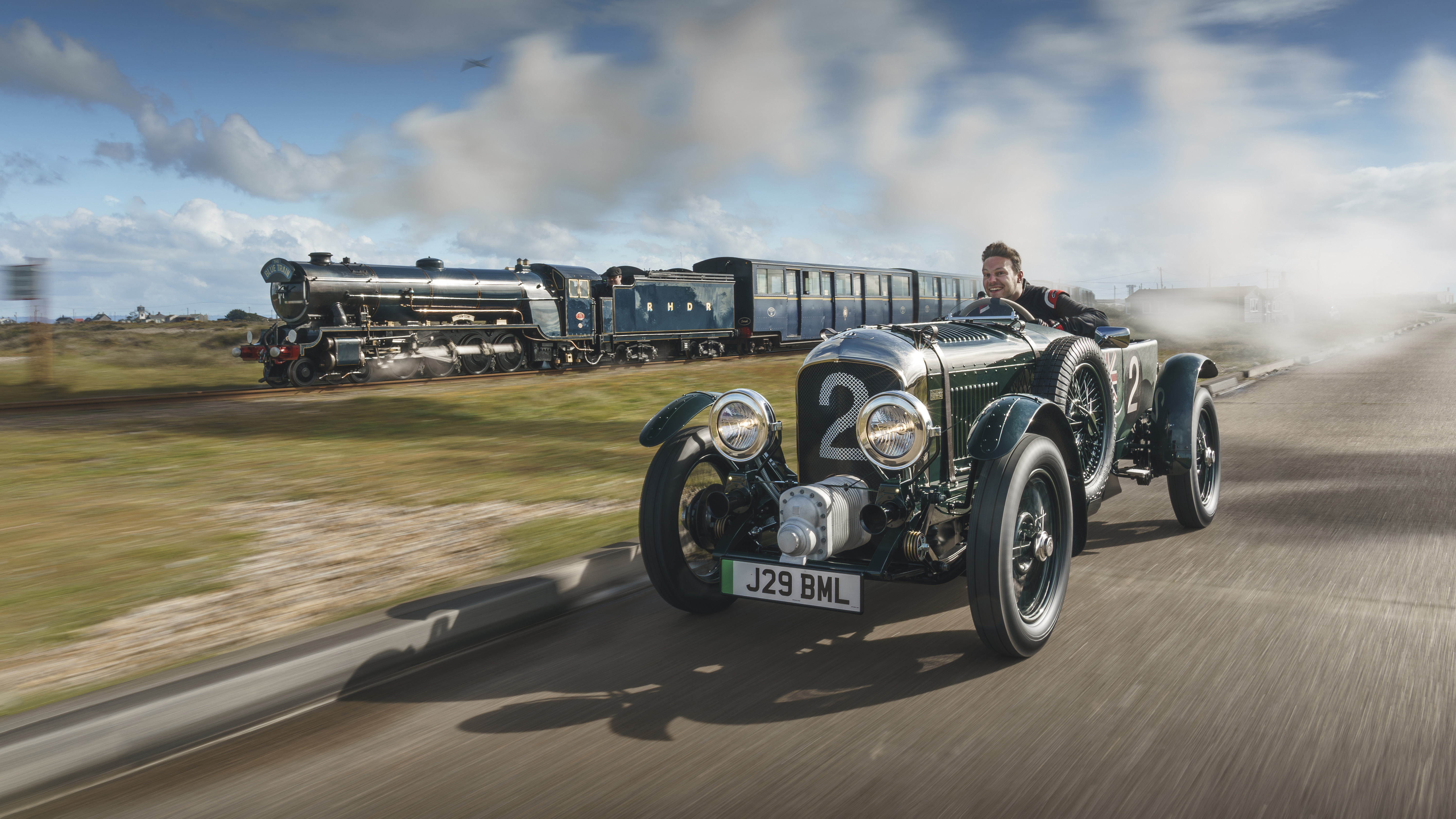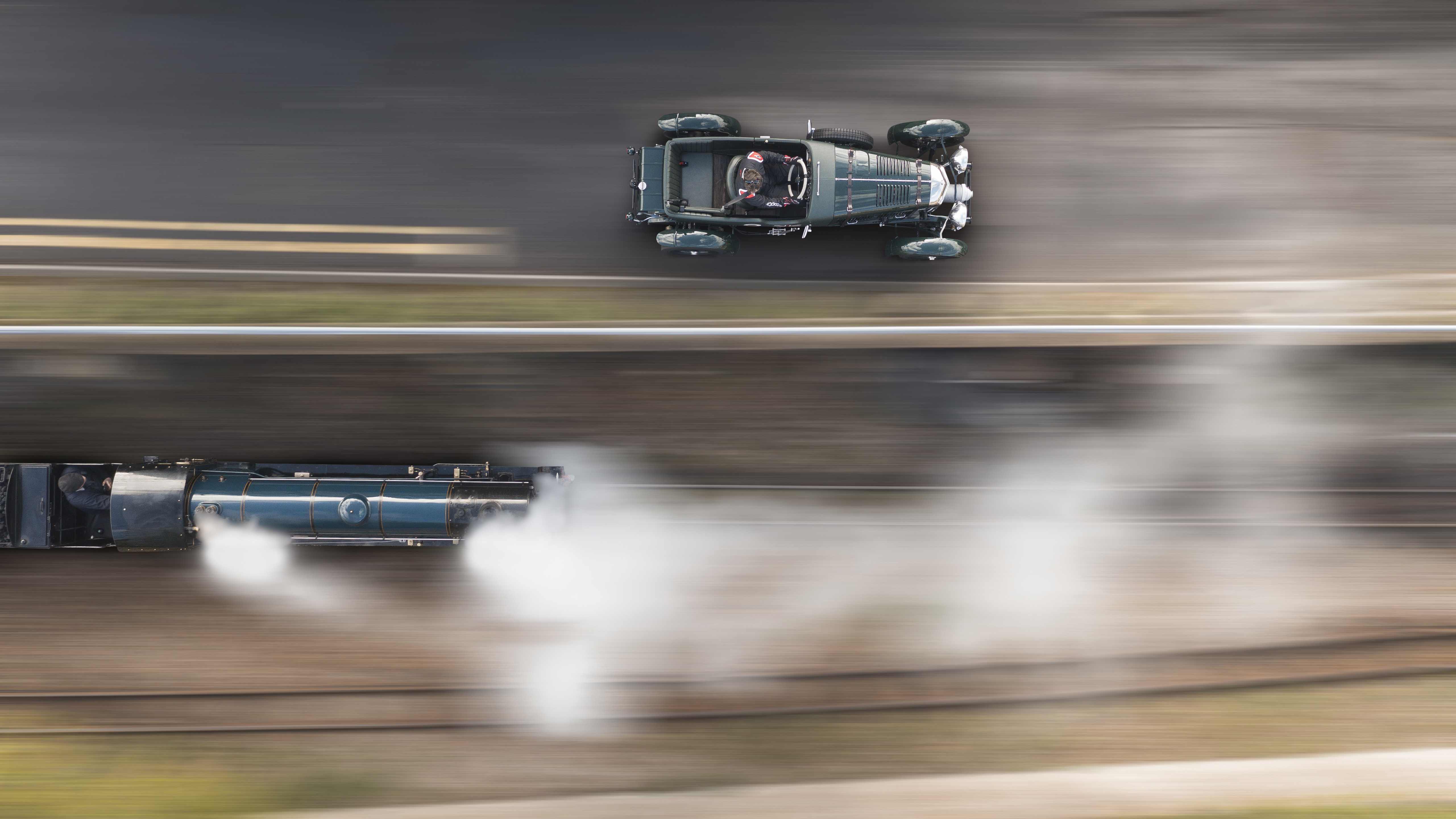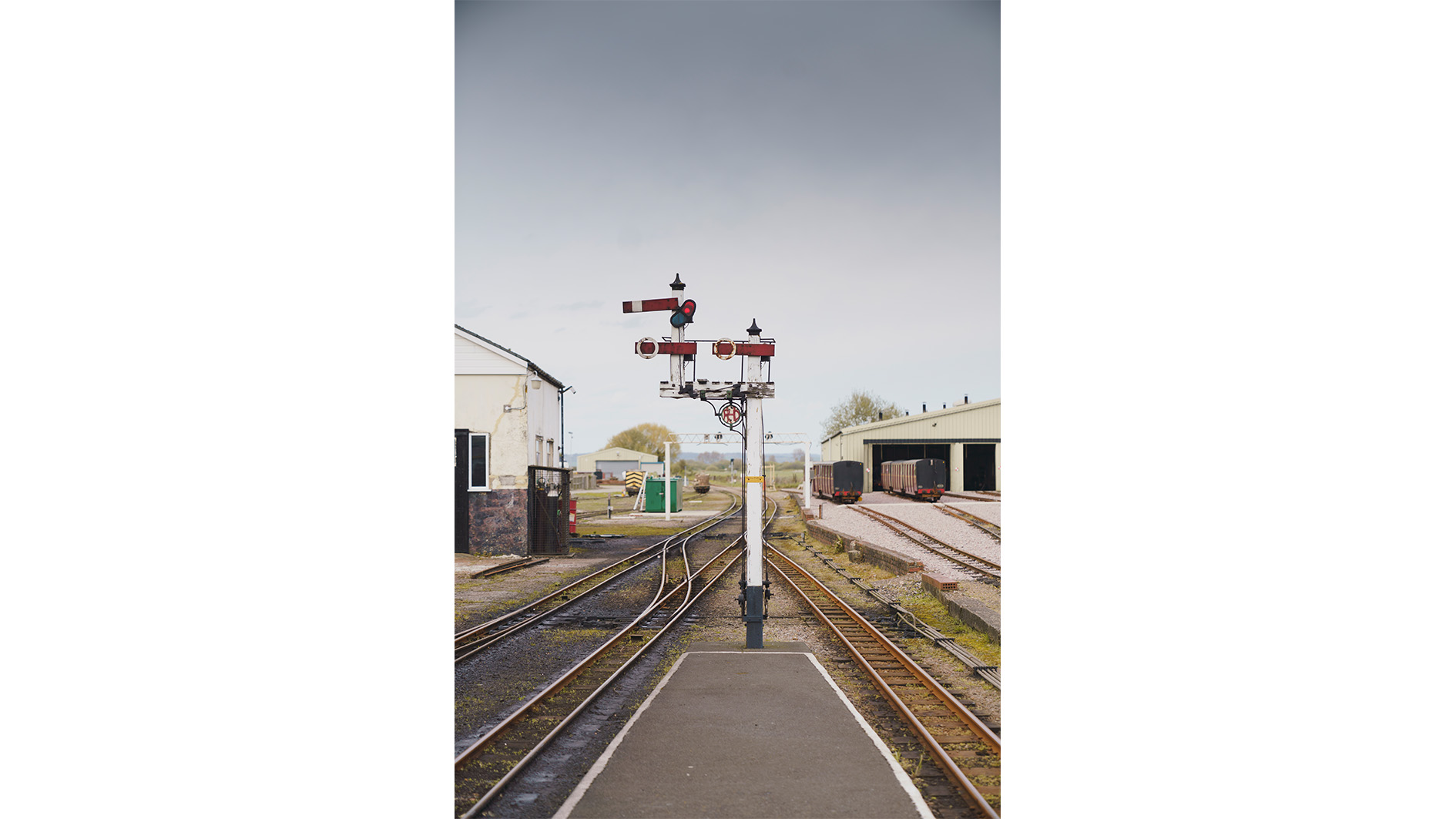
Smoky and the bounder: LCC Bentley Blower Jr vs Samson steam train
A shrunken Bentley Blower racer gave us a grand idea: recreate one of the British toff’s finest hours in miniature. All aboard...
Oh, the smell. Sultry wafts of coal-fired smoke, laced with hints of hot metal, warm engine oil and lashings of grease. An impatient steam locomotive is a feast for the eyes, ears and nose. All eight tonnes of Samson, built in Colchester in 1926, are ready to haul the first train of the day.
The car alongside doesn’t pour any nostalgic odours into the morning air. It doesn’t make a sound. But it does look the part, because this is the latest work of Oxfordshire’s The Little Car Company, who I’ll be reporting to the Trading Standards office because its new Bentley Blower Jnr isn’t little at all. It’s enormous. A half-tonne toy for 21st century Bentley Boys.
What we have here is a hand built, 85 per cent scale replica of the supercharged Bentley ‘Blower’ Le Mans car of the late Twenties. It’s an approved, authentic, fully operational electric homage to real life unobtainium. Bentley let TLCC scan its prized Blower (value £25 million) to guarantee accuracy.
It’s only the second ‘Little’ Car to be road legal, after the Tamiya Wild One buggy. The Bentley has numberplates and a 65-mile range. It’ll maintain a 45mph cruise. It’s got seat belts and a reversing camera. You could commute in this. Or moonlight as the world’s most caddish Uber Eats deliverer.
Photography: Dean Smith
Not likely – it costs a mighty £90,000. Plus tax. Plus delivery. Plus options, like livery, upholstery and trim. This is one of 99 First Editions, resplendent in British Racing Green with a quite beautiful aluminium dashboard atop a carbon fibre tub. The dials scattered behind the string-wrapped steering wheel are repurposed to show range, speed and motor power. When you’re not reversing, the digi-screen displays an ornate, Roman numeraled clock. And what would’ve been the manual fuel pump is reimagined as your mode switch. Choose from comfort (2.5bhp), Bentley (10.7bhp) and sport (20bhp).
A miniature Bentley one can drive on the King’s highway? Only one thing for it, I thought. A small race against a tiny train.
Why? Two reasons. First, because this job allows me to live out childhood fantasies on your behalf and no one at the BBC has noticed. And second – there’s a legendary historical precedent.
A hundred years ago, the chief currency in selling cars was reliability. The power and pixel wars were decades away. Le Mans was dreamt up because common wisdom deemed it nigh-on impossible that a motorcar could run fast and fault-free for 24 hours straight.
Bentley’s chairman Woolf Barnato, millionaire heir to a South African diamond mine, had a hat trick of victories in the French endurance classic. Though his company was dogged by financial earthquakes Barnato was adamant that proving his cars could run harder for longer was vital for survival.
Imagine his displeasure in the spring of 1930 when Rover and Alvis trumpeted boastful advertisements their cars had outpaced one of the continent’s most famed long-distance luxury trains – the Calais-Mediterranée Express – on its 750-mile journey from Calais to the Côte d’Azur. The story goes Barnato scoffed (while attending a dinner party aboard a yacht in the French Riviera) such feats were “no great shakes” and that he would humiliate it.
The romantic story contends that quarter to six the following evening (having seen off a monstrous hangover) Woolf and his golfing partner were relaxing in the Carlton hotel in Cannes. When they received a telegram confirming The Blue Train had left the station, they finished their drinks, strolled out and struck up Barnato’s Speed Six saloon. And off they went, into history.
Despite overnight rain, a puncture and bribing a petrol station in Lyon to stay open and refuel the car, Woolf and Dale romped to Calais by 10.30am. But they weren’t finished. Having wired ahead for a speedy customs check, he boarded a packet steamer ferry and sailed across the English Channel, disembarking at Dover and roaring north. After a headlong overnight dash of almost 800 miles, the filth-streaked Bentley screeched up to the Conservative Club in the City of Westminster at 3.20pm – four minutes before The Blue Train’s arrival in Calais.
The French were cross, banning Bentley from attending the 1930 Paris Motor Show and fining Barnato for racing on public roads. A year later the Great Depression had ravaged company finances, and rival Rolls-Royce swooped in to buy Bentley. So the Blue Train race really was the last hurrah of the Bentley Boys: from the Riviera to London in time for afternoon tea. Superb.
Top Gear
Newsletter
Thank you for subscribing to our newsletter. Look out for your regular round-up of news, reviews and offers in your inbox.
Get all the latest news, reviews and exclusives, direct to your inbox.
The prize of my shrunken rematch was ‘last one to Dungeness buys breakfast’, but engine driver Alex has added to the delicious smells at New Romney station by sizzling eggs and bacon on the coal shovel. We’re staying firmly on our side of the Channel today. The start line is New Romney station halfway along the Romney, Hythe and Dymchurch Railway in Kent. The train will spear straight towards the end of the line in the shadow of Dungeness nuclear power station, while the car winds its way out of Romney and follows the beach front towards the finish, six miles south.
Samson couples up to nine tonnes of carriages and blows his mournful whistle. The guard peeps his own and on the dot of just after 8.38am the train surges away, great jets of steam issuing from its copper drain cocks while a column of smoke launches from the chimney. Bentley vs Blue Train partie deux is go. Tally-ho!
I beat a Le Mans start, legging it into the car park, clambering off the mounting step and knocking the gold ‘ignition timing’ switch into Drive. The train has disappeared into the tunnel under Littlestone Road as I wait for a gap in the traffic. Top tip: if you need someone to give way, drive a bonsai Twenties Bentley.
We’re underway, heading coastal past the Captain Howey hotel, named after the eccentric millionaire racing driver who decided to build this ultimate 15in gauge train set in 1925 with friend and fellow monied racing enthusiast Count Louis Zborowski – the original driver of ‘Chitty Bang Bang’.
The Blower Jnr isn’t going bang bang. It’s whirring along, emitting a pedestrian-alerting sci-fi whine that shuts off above 25mph, when the racket from the leaf springs and friction dampers becomes the loudest part of the ensemble. This is not a comfortable car. The Bentley hide trimmed seat is luxuriously padded, but authentic Twenties suspension technology and slender cross-ply tyres give the Blower Jnr decidedly lively road manners. So, assume the position. Shoulders hunched. Elbows pointed. Saw at the wheel and grimace through the aero screen.
I’ve strapped a walkie-talkie to my seatbelt. TG’s videographer Charlie Rose is aboard Samson’s cab and reports the train is scything along at its maximum allowed speed of 25mph. The car’s subject to a 30mph limit here, and there’s a brief dash of 40mph running to come, but his route is much more direct, with no roadworks or Give Way signs. I lose vital moments waving a skip lorry through a bottleneck then get snared by a red light as the power company digs up my racetrack, but as The Pilot Inn hoves into view I’m regaining time.
Meanwhile engineman Alex has Samson steaming on song. Boiler pressure is stable and he’s flicking coal deftly into the firebox’s corners, skilfully avoiding singeing his knuckles. He knows his engine’s foibles and moods and how to coax the most efficient running from this elegant metallic dragon, which stood derelict from 1939–1946 while an armoured classmate towing an anti-aircraft gun patrolled the RH&DR in case the Germans invaded. I’m not joking. Kent’s first landborne defence during WW2 was an armour-plated narrow gauge steam train.
Rounding a tight leftie hairpin onto the Dungeness Estate... disaster. The level crossing lights blink gleefully and the barriers plunge down. A triumphant whistle blares from stage left as Samson, his driver, and a face-sooted Charlie charge into the lead, with Dungeness merely minutes away.
A triumphant whistle blares from stage left
As the final carriage trickety trocks out of my path, the barriers clear and I summon all 20 horsepower. “Brandy... Brandy! Here, now!” Not for me: a startled dog walker’s lost her labradoodle and looks dazed as I barrel past her and the furry menace, and zoom down the rickety lane. Round a sweeping right-hander, the idyllic lighthouse is in sight, marking the end of the line. The train is only identifiable by the feather of smoke puffing into the sea breeze – but he’s catchable.
And slowing. The approach to Dungeness station is a tight right hand curve and Samson’s reciprocating rods have to be restrained to negotiate the track work ahead of the platform.
I tuck myself as deep as I dare into the Bentley’s fuselage and keep the pedal pinned as the road meets the railway for a photo finish.
We’re passing carriages in a blur. I detect that gorgeous odour on the air once more. Enveloped in steam, smoke and vibration, the Blower charges past Samson on the final stretch and lunges onto the station approach as the locomotive coasts into its siding.
By mere seconds, the little car has repeated its full-size triumph over the charming train and victory smells good.
Trending this week
- Car Review
BMW 1 Series











